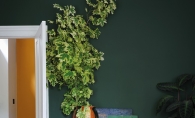Wayzata High School senior Emma Sisk, like many of us, was not a fan of bees as a kid. Bees can seem pesky and nobody wants to get stung. As she grew older, she got used to them after developing a passion for gardening. These days, she’s gained a new appreciation for bees after completing a school project, and she’s hoping to spread the word that they aren’t just non-threatening—they’re crucial to our everyday lives. “A lot of people just think of them as kind of a nuisance in their yard, but they’re really important,” she says. “Everybody would be affected by bee loss.”
When we think about bees and food production, honey likely first comes to mind. But bees are also responsible for the pollination of countless crops, including apples, oranges, avocados and almonds.
Bees pollinate about one-third of the foods we eat, which amounts to more than $15 billion in crop value, according to the U.S. Department of Agriculture. Because of several factors including habitat loss and disease, the USDA estimates the number of managed bee colonies has dropped from 5 million in 1940 to 2.5 million today.
After noticing these alarming trends in the news and researching bee loss, Sisk decided to focus her 15-page research paper for her economics class on the issue. She wrote in favor of a United States House of Representatives bill that would suspend the use of a type of pesticide called neonicotinoids, which have been shown to be toxic to bees.
Sisk learned there are many simple ways for Plymouth residents to help bees thrive. Here are some steps we can all take to help our pollinator friends:
Plant bee-friendly flowers
Planting the right flowers is one of the easiest—and prettiest—ways to help preserve bees. All bees rely on pollen and nectar from flowers for food, says Elaine Evans, a PhD student at the University of Minnesota and captain of the U of M Bee Squad’s Wild Bee Team. Sisk suggests planting coneflowers, asters, sunflowers, poppies, bee balm and sedums. With more than 400 species of bees living in Minnesota, Evans says it’s important to plant a variety of flowers with different blooming windows. While planting bee-friendly flowers will draw more of them to your yard, they’ll pollinate your garden in return for the favor.
Avoid pesticides
Evans says most pesticides are likely to be harmful to bees and should be avoided as much as possible. Neonicotinoids can be especially toxic because they are absorbed into plant tissue for long periods of time. Aside from checking labels, Evans says it’s important to check with the nursery you buy from to make sure your plant is clean. Another option is to simply start plants from seeds yourself.
Provide habitat
In addition to clean food, bees need somewhere to nest. For the 70 percent of bees that nest in the ground, Evans suggests leaving some areas of soil in your yard undisturbed. “Working with the habitat that you have and leaving some untouched corners can really do a lot,” she says. For the 30 percent of bees that nest in cavities like holes in wood or plant stems, Evans recommends leaving 6 to 12 inches of stem stubble when you’re cutting back your perennials.
Donate to research institutions and non-profits
Evans says the U of M Bee Lab’s renowned researchers can always use donations, adding that non-profit Pollinate Minnesota also does great educational and advocacy work. Sisk suggests donating to Pollinator Partnership, a non-profit dedicated to protecting pollinators.
Sisk says she plans to plant some new flowers and do what she can to help bees before she heads to college to study food science.
&
For a list of bee-friendly plants, details on pesticides, instructions on how to build a bee nest and more information, visit the University of Minnesota Bee Lab’s resources at beelab.umn.edu.









